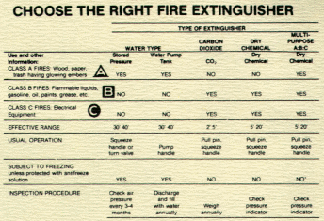Introduction
Each year in Canada, there are approximately 800 deaths due to fires. While the majority of these deaths are in conjunction with residential properties, many occurred on farms. Fires on farms pose a special threat, unlike an urban or city property that has immediate access to a well organized fire department and an abundance of water. Most farmers are relatively isolated from fire fighting equipment and may lack adequate water for fighting a fire. As a result of this, the economic losses due to fires in farming are severe and out of proportion to the actual number of fires occurring.The leading causes of fires are: careless smoking; faulty electrical equipment; and, faulty heating equipment. Other causes of farm fires could include lightning and the improper storage or use of flammable liquids. This fact sheet deals generally with the prevention of fires and fire fighting equipment and techniques.
How Fires Burn Fire
Classes
Fire
Classes
Class B Fire - flammable liquids, gasoline, oils, fats, etc.
Class C Fire - live electrical wiring, motors, appliances, etc.
Class D Fire - combustible metals, magnesium, potassium, etc.
Fire Extinguishing EquipmentPortable fire extinguishing equipment is available in a variety of sizes and shapes. All portable extinguishing equipment is rated or classified for the class of fire they are capable of extinguishing. Choosing the right extinguisher for a fire is extremely important if a fire is to be put out quickly and safely. For example; an "A" rated fire extinguisher can be used to extinguish a Class "A" fire, a "B" rated fire extinguisher can be used on a Class "B" fire, and a "C" rated one for a Class "C" fire, and so on.
Many fires however, can't be classified strictly as one type, they may involve a variety of flammable materials. For this reason, multi-rated extinguishers have been developed. (See Chart.)
Owing to the variety of work conditions that exist on the farm, farmers are advised to use an all purpose, A.B.C. rated extinguisher. This extinguisher uses a dry chemical agent and is capable of extinguishing Class A, B or C fires. The extinguisher is available in a variety of sizes and is not susceptible to temperature extremes.* All portable extinguishing equipment should be strategically located on the farm and checked regularly. Everyone on the farm should be trained in the safe use of extinguishers.
Warning -- Carbon Tetrachloride ExtinguishersOnce everyone is out of the building, call the fire department. Give your name, address, and the exact location of the fire. Have the person you're talking to repeat your instructions. Never allow anyone to re-enter a burning building!
 *
A:B:C dry chemical extinguishers that are exposed to sub-zero
temperatures for prolonged periods of time may freeze. Special
cartridge activated extinguishers should be used for sub-zero
applications.
*
A:B:C dry chemical extinguishers that are exposed to sub-zero
temperatures for prolonged periods of time may freeze. Special
cartridge activated extinguishers should be used for sub-zero
applications.
Publication #: F-003
The information and recommendations contained in this publication are believed to be reliable and representative of contemporary expert opinion on the subject material. The Farm Safety Association does not guarantee absolute accuracy or sufficiency of subject material, nor can it accept responsibility for health and safety recommendations that may have been omitted due to particular and exceptional conditions and circumstances.
Farm Safety Association Home Page
Disclaimer and Reproduction Information: Information in NASD does not represent NIOSH policy. Information included in NASD appears by permission of the author and/or copyright holder. More